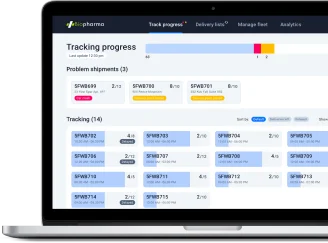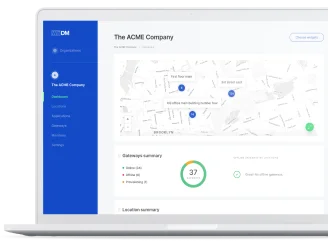Enterprise software development
Build a cost-effective and complementary product ecosystem that covers all your business scenarios in one go, with elements that integrate and interact under the hood.
-
Manage all of your operations, resources, and finances from a unified system
-
Ensure proper interaction among your departments and branches
-
Speed up software development to minimize time to market and value delivery for your customers
-
Obtain business agility for stable business growth and effective problem-solving
-
Build a software system that supports and accelerates disruptive innovation
-
Implement a scalable and secure solution that can be integrated with other systems
Benefits of cooperation with a trusted enterprise software development company
-
Comprehensive engineering experience
With over 15 years of experience in software development, we understand complex requirements, select the most suitable architecture and product design, and implement best practices for efficient and robust software development.
-
Highly complex systems
Our portfolio comprises over 200 projects. We create complex software solutions for the top 10 Fortune 500 companies. Such solutions may involve multiple modules, integrations with external systems, and sophisticated user interfaces.
-
Immersion into your business
Yalantis’ experts dive deep into your business to gain a complete understanding of needs and objectives. As a result, you get a strategic collaborator offering insights, solutions, and guidance beyond mere software development.
-
Regulatory compliance
To create high-quality and secure software, we follow standards and regulations including ISO 27001, ISO 9001, ISO 27701, and the GDPR. We also adhere to effective and budget-saving cybersecurity best practices and compliance with industry regulations.
Enterprise software development services Yalantis offers
-
Digital transformation
-
Designing an interoperable product ecosystem
-
End-to-end software solution implementation
-
Process optimization and digitalization
-
Legacy system modernization
-
Top-notch software security
-
-
Data management and migration
-
Data integration and interaction
-
Data transformation and translation
-
Data warehousing
-
Data aggregation and visualization
-
Cloud and DevOps solutions
-
Business intelligence and data analytics
-
-
Security and governance
-
Regulatory compliance
-
Role and permission management
-
Multi-factor authorization
-
Single sign-in
-
-
Mobile solutions
-
Remote communication software
-
Task and productivity management
-
Customer portals
-
Fully functional mobile apps
-
-
Third-party integrations
-
Enterprise resource planning
-
Customer relationship management
-
Human resource management
-
Analytics and business intelligence tools
-
Accelerated implementation
-
-
Legacy modernization
-
Elaboration of new products for the ecosystem
-
Consolidation of separate products into an ecosystem
-
Extension of system capabilities
-
Creation of a unified UI and UX for all system elements
-
Have a specific business requirement and aren’t sure how to meet it with technology?
We have the solution.
Works created and augmented by Yalantis enterprise software developers
Full-cycle software development for your business goals
Whether you need consulting services, a complex fully integrated software ecosystem, or support for your current applications, we are here to help.
Insights into building and upgrading enterprise software solutions

What to consider to build a successful digital transformation roadmap for your logistics company
Use practical insights from this article to prepare for building a digital transformation roadmap that can help your supply chain business grow.

Healthcare business transformation: digitalize your clinical routines
Digitalization in healthcare is picking up steam. Learn how to build an all-in-one management solution that will help you optimize your clinical routines.

Cloud migration checklist: 7 steps to successful app migration
In this extensive guide, we unveil the top reasons for cloud migration, touch upon security concerns, and discuss the process of cloud migration step-by-step.
Frequently asked questions (FAQ)
How can your enterprise software engineering services help me strengthen my product ecosystem?
By ensuring modularity and scalability, applying an API-first approach, embracing open standards to provide interoperability with other systems, and following other effective strategies, we can strengthen your product ecosystem around your enterprise software solution. This will create a thriving environment that offers expanded functionality, increased value, and a seamless user experience. Two types of solutions below offer detailed examples of how we can enhance your product ecosystem.
UI and UX solutions:
- Design a user experience based on your target audience’s key needs and problems and industry standards.
- Implement a consistent user experience and multiple user roles with unique functions across all platforms.
- Build a product information architecture, feature map, user role matrix, and interactive software prototype.
- Get a well-documented design system built for quick scaling and rapid implementation of new features.
Communication integrations:
- Build a full-scale communication platform and communication modules for your business needs.
- Streamline communication and collaboration with one-on-one and group chats, audio and video calls, announcements, bulk emailing, and read-only channels.
- Ensure communication security with end-to-end encryption, user administration, permission management, and more.
- Improve interactions with your audience through deep analysis of cohort behavior, search queries, and other user-generated data.
Can you provide domain-related enterprise software development services?
We have vast experience creating complex domain-specific software systems for the IoT, healthcare, manufacturing, supply chain, real estate, FinTech, EdTech, retail, and media and entertainment industries. Here are just a few examples of what we can offer for three of these industries:
Healthcare. We build compliant and secure EHR, EMR, ERX, and other technical solutions for the medical industry. They help healthcare providers ensure reliable medical data management and implement telemedicine, appointment scheduling, and other functions to improve service delivery.
FinTech. We create digital payment, banking, wealth management, and financial software. These solutions help businesses digitize billing, charging, and other manual routines as well as provide new payment options. To secure businesses from fraud and other financial risks, we ensure compliance with PCI DSS, KYC, and other standards, laws, and regulations, provide advanced anti-fraud solutions, and more.
Supply chain. We provide custom TMS, WMS, FMS, MES, ERP, and other logistics solutions that help logistics companies streamline decision-making, reduce costs, automate order distribution, optimize transportation operations, boost customer loyalty, and more.
What is your approach as an enterprise software developer?
There are seven steps we follow to ensure successful enterprise software solution development:
- Analysis. Conduct an in-depth analysis of your business and IT systems.
- Desired state modeling. Model the desired state and scenarios and define missing system elements.
- Solution design. Create a solution design that covers all scenarios with proper system elements.
- Architecture design. Design a flexible and integration-ready architecture.
- Platform-agnostic development. Develop all system elements using a platform-agnostic approach.
- Continuous delivery. Set up continuous delivery and integration for regular and stable releases.
- Product support. Provide post-release support and maintenance services for each system element.
An enterprise software solution as a powerful tool for boosting your company’s operations
Enterprise software solutions are comprehensive applications or systems specifically designed to address the complex needs of large organizations. These solutions provide a range of functionalities and tools that help businesses streamline their enterprise operations, increase productivity, improve collaboration, and manage various aspects of their organization more effectively.
Enterprise application development typically covers multiple areas of modern business operations:
- Enterprise resource planning (ERP) solutions integrate and automate core business processes including finance, accounting, human resources, inventory management, and procurement. They provide a centralized system to manage and track various aspects of a company’s operations.
- Customer relationship management (CRM) software enables businesses to consistently communicate with clients and leads. These systems typically include features for managing sales leads, tracking customer data, managing marketing campaigns, and providing customer support and service.
- Supply chain management (SCM) solutions focus on optimizing the flow of goods, services, and information across the entire supply chain. They help businesses manage inventory, procurement, logistics, and supplier relationships to ensure efficient operations and timely delivery of products or services.
- Human resources management (HRM) solutions assist in managing various HR processes including employee data, payroll, benefits administration, performance management, recruitment, and employee self-service portals.
- Project management solutions provide tools for planning, tracking, and managing projects and resources. They help businesses allocate resources, track progress, manage tasks, collaborate with team members, and ensure projects are completed on time and within budget.
- Business intelligence (BI) software allows companies to analyze and represent data on business performance taken from multiple sources. They often include reporting and dashboarding features to provide executives and decision-makers with actionable information.
- Collaboration and communication solutions focus on improving internal communication, collaboration, and knowledge sharing within an organization. They may include features like email, instant messaging, document sharing, team collaboration tools, and intranets.
Enterprise software solutions can be off-the-shelf products that are customized to some extent to fit an organization’s specific requirements or are created as a result of custom enterprise software development and tailored to the organization’s unique needs. Mature enterprise software developers like Yalantis design enterprise systems to be scalable, secure, and capable of integrating with other systems and technologies already in use within the enterprise.
Implementing an enterprise software solution can significantly enhance an organization’s efficiency, productivity, and decision-making capabilities, allowing the organization to stay competitive and adapt to a changing business environment.
Solution design: an approach followed by our enterprise software development company to craft enterprise apps
Solution design is the process of creating a well-thought-out and comprehensive plan for developing custom software that effectively addresses a specific problem or meets a set of business requirements. It involves careful analysis, strategic thinking, and creative problem-solving to design a solution that aligns with desired outcomes and objectives.
During solution design, the focus is on understanding the problem at hand and gathering detailed requirements from stakeholders. This includes conducting thorough research, engaging in discussions, and collaborating with domain experts. The collected information is then carefully analyzed to gain a deep understanding of the problem’s context, challenges, and desired outcomes. Based on this understanding, the solution designer formulates a detailed plan and blueprint for the software solution.
To draw such a plan, a solution designer should:
- consider scalability, flexibility, performance, security, and usability aspects while crafting the solution design
- collaborate closely with stakeholders, domain experts, and development teams to ensure value-driven development
- include various elements such as system architecture, data models (data models examples), user interfaces, functional components, integration points, and technical specifications
5 pillars of solution design at our enterprise software development company
Yalantis is a full-scale software development company. We provide end-to-end advisory and delivery services and support. Our proprietary project and product management approach is powered by seven key pillars: our engagement process framework, delivery approach, quality gates, product vision and architecture design methodologies, cost-optimized SDLC process, solutions accelerator, and DevOps infrastructure accelerator.
Engagement process framework
Finding a software provider that ensures transparent and clear engagement can be difficult. Software providers often fail to properly communicate their values, might not meet your expectations, and are slow. Our enterprise software development company sets up smooth and effective engagement with our clients thanks to:
- a transparent communication plan
- quickly understanding business objectives by creating a business objective model, value stream, product vision board, situation statement, etc.
- clear proposals with detailed business and technical parts defined via user story maps, business and technical diagrams, and an architectural vision
- precise budget calculations and timelines implemented via project management elements such as a schedule, milestones, and deliverables
Delivery approach
When choosing a software vendor, make sure they have a track record of delivering the types of services you need. For example, Yalantis guarantees:
- a transparent SDLC. All stakeholders have clear visibility into development stages, activities, and decisions involved in enterprise software engineering. This ensures that information flows openly and allows stakeholders to understand and effectively contribute to the development process.
- clear delivery targets. We set goals for each custom software development project in terms of the timeline, budget, and functionality. These targets help guide project planning, execution, and success evaluation.
Quality gates
When selecting a software vendor, make sure they provide transparent quality controls for your project. At Yalantis, we ensure:
- software development process quality checks and regular audits (code reviews, SDO checks and audits, etc.)
- quality assurance (PMO/BAO/QMO audits, involvement of ISTQB-certified associates, test planning and execution, etc.)
- security audits (threat modeling, execution/development environment review, etc.)
- performance management (performance metrics/reports, product demos, etc.)
Product vision and architecture design methodologies
Enterprise software developers often offer various solutions to the same business need. But it’s challenging to compare them, choose the most suitable, and make sure that the vendor hasn’t overlooked the most optimal solution. You can rest assured that this won’t happen if you cooperate with Yalantis thanks to:
- a clear product vision scope for the target solution
- a comprehensive architectural vision with details on how non-functional requirements will be addressed
- a transparent feature map and milestones
- business-driven/technical workshops and brainstorming sessions
Cost-optimized SDLC process
The budget and timeline are always key considerations when implementing any solution. But there are always risks of overestimating, underestimating, missing requirements, or making wrong assumptions. Such risks may lead to missed deadlines, extra development costs, and compromises in quality. Here’s what helps Yalantis ensure cost-effective enterprise app development:
- Tracking of delivery processes in accordance with a project plan
- Timely prevention or prediction of unexpected expenses
- Visibility over the spent and remaining budget
- A technical group for validating cost-efficiency and checking possible optimizations
- An iterative solution design process to review architectural decisions and select reference architectures for reusability
Solution accelerator
Enterprise software development companies typically offer complex and overengineered greenfield solution development that is costly and time-consuming. In addition, such an approach holds the risk of software bugs and missed deadlines. Our solution accelerator helps us utilize custom-developed modules and reliable third-party solutions to provide you with the following benefits:
- Up to 20% shorter time to market
- Up to 20% lower defects ratio
- Delivery on time and within budget
- Up to 15% reduction in project development costs thanks to following industry best practices and reusing tools and components
DevOps infrastructure accelerator
Software development companies find it challenging to efficiently develop solution infrastructure for businesses without compromising security, development speed, and overall product quality. So as not to reinvent the wheel and in order to meet budget requirements without overspending on commonly developed functionality, we provide a combination of a development framework and commonly implemented infrastructure features using predefined solution components (Infrastructure as Code modules). This approach brings you the following benefits:
- Faster development. Save from 25% to 75% on development efforts for commonly used features or tasks.
- Quick project bootstrapping. Get the first demo in the first week of engagement.
- Quick environment provisioning. Get a basic working environment in days, not weeks.
SonarQube: an effective tool that enables us to ensure high-quality code
SonarQube is an open-source web-based platform that provides continuous visibility and control over code quality in various programming languages. Using SonarQube, developers, teams, and organizations can identify and address code issues, improve code maintainability, and ensure adherence to coding standards.
Business and technical benefits provided by SonarQube
Detects and alerts:
- Reduces the business and financial impact of undetected issues
- Minimizes the risk of broken software in production
- Finds bugs and notifies developers to fix them before rolling out to production
- Reduces the chance of misinterpreting complex parts of code
Productivity:
- Improves productivity by allowing developers to identify and mitigate code duplication and redundancy
- Reduces the risk of extra time and costs when making changes in application code
SonarQube helps in the on-time delivery of quality products and improves software sustainability. One more benefit is that thanks to this tool, software engineers can obtain regular feedback on code quality problems, which can help them enhance their programming skills.
Solution design deliverables we provide
User story map to transport solution requests from the service requester to the correct internal or external service providers
Architectural vision that describes the baseline and target architectures from a business as well as a technical perspective
Roadmap, timelines, and milestones to describe key project milestones and associated features
A budget plan, which includes cost planning and a breakdown structure according to the defined roadmap and technical skillset
Conclusion
Choose our enterprise software development services if you want to:
- have a technical partner capable of delivering enterprise-level solutions
- work with a versatile technical partner with strong domain expertise and an extensive portfolio
- decrease personal involvement in the project management process
- benefit from optimized development costs and a sped-up delivery process
- build a secure solution and protect your business data
Collaborate with Yalantis

got it!
Keep an eye on your inbox. We’ll be in touch shortly
Meanwhile, you can explore our hottest case studies and read
client feedback on Clutch.
Yalantis in brief
-
15+
years of experience
-
500+
IT experts aboard
-
35+
active clients
-
Project inquiries
-
Careers
-
Phone number
+ 1 213 4019311
Our offices
-
Poland
123 Jerozolimskie avenue, Warszawa, 00-001 -
Ukraine
12 Vasylya Stusa street, Lviv, 790005 Dmytra Yavornytskoho Avenue, Dnipro, 490058 Illinska street, Kyiv, 04070 -
Cyprus
8 Athinon street, Larnaca, 6023 -
Estonia
12 Parda, Tallinn, 10151




